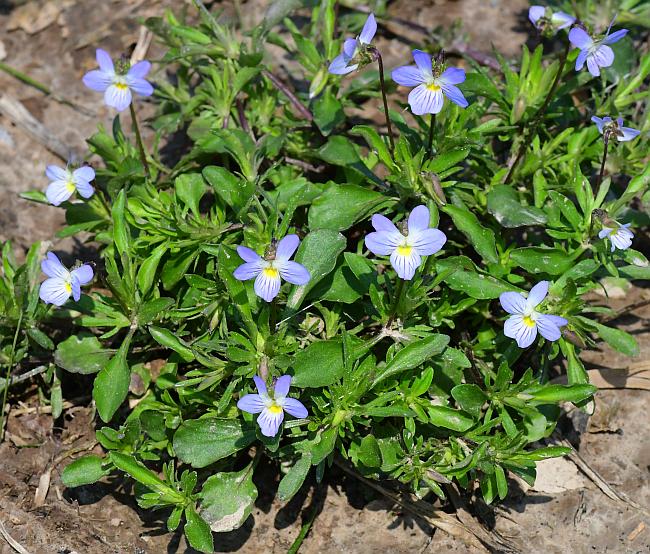Viola bicolor Pursh
Johnny-Jump-Up

Native
CC = 0
CW = 3
MOC = 78
© SRTurner
Viola bicolor PurshJohnny-Jump-Up | |
 |
Native CC = 0 CW = 3 MOC = 78 |
© SRTurner |
|
Family - Violaceae Habit - Annual forb with a slender taproot. Stems - Ascending to erect, to 25 cm, angled, glabrous or pubescent. Leaves - Basal and alternate, stipulate, long-petiolate to nearly sessile. Stipules relatively large and leaflike, free from the petiole, deeply lobed with a fringe of several, long, linear or oblong-lanceolate segments on each side, the terminal segment similar to the lateral ones, entire or with 1-2 pair(s) of blunt or rounded teeth along the margins. Leaf blades 0.7-3.0 cm long, unlobed, obspatulate to nearly circular, rounded or angled to a bluntly or sharply pointed tip, truncate to rounded at the base, the margins otherwise entire or with 1-2 pair(s) of blunt or rounded teeth, the surfaces glabrous.
Inflorescence - Single flowers from leaf axils. Peduncles typically exceeding leaves, glabrous, curved downward at apex, to 4 cm long, with two minute (1 mm) bracts near base of curve.
Flowers - Sepals 5, lanceolate, 3-5 mm long, glabrous, with basal spur to 1.5 mm long. Margins of sepals slightly darker green than interior. Corollas zygomorphic, 1.5 cm broad. Petals 5, distinct, typically bluish to whitish with purple lines. Lower petal with yellowish base near throat of corolla. Lateral petals bearded. Stamens 5. Stigma globose.
Fruits - Capsules 4-6 mm long, broadly ellipsoid, green drying to tan, the surface glabrous, enclosed within persistent sepals. Seeds 1.3-1.5 mm long, tan.
Flowering - March - May. Habitat - Fields, waste ground, disturbed sites, meadows, roadsides, railroads. Origin - Native to the U.S., probably. Lookalikes - Viola tricolor, but this species is rare in Missouri. Other info. - This tiny species of violet is quite abundant in the spring months. It is common across Missouri, and occurs throughout most of the eastern U.S. The depth of color of the corolla is quite variable, ranging from nearly white to almost purple. Identification in the field is easy based on general appearance. The deeply lobed stipules are also distinctive. Although the very uncommon (in Missouri) V. tricolor can resemble Johnny-jump-up, the corollas of that species are normally much more deeply colored. Photographs taken in Vale, NC., 3-9-03 (DETenaglia); also at Pickle Springs, St. Genevieve County, MO, 4-26-2014, near Labadie, Franklin County, MO, 3-28-2018, 5-1-2019, 4-1-2020 and 4-25-2021, Riverfront Park, Washington, Franklin County, MO, 5-13-2018, and at Canaan Conservation Area, Gasconade County, MO, 4-26-2021 (SRTurner). |